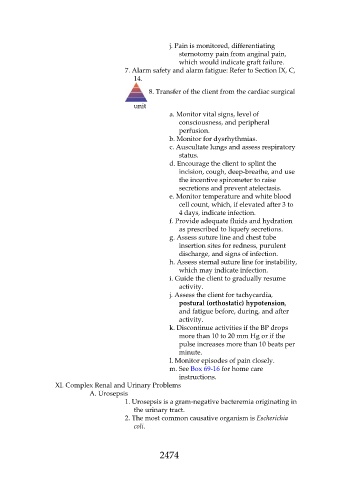Page 2474 - Saunders Comprehensive Review For NCLEX-RN
P. 2474
j. Pain is monitored, differentiating
sternotomy pain from anginal pain,
which would indicate graft failure.
7. Alarm safety and alarm fatigue: Refer to Section IX, C,
14.
8. Transfer of the client from the cardiac surgical
unit
a. Monitor vital signs, level of
consciousness, and peripheral
perfusion.
b. Monitor for dysrhythmias.
c. Auscultate lungs and assess respiratory
status.
d. Encourage the client to splint the
incision, cough, deep-breathe, and use
the incentive spirometer to raise
secretions and prevent atelectasis.
e. Monitor temperature and white blood
cell count, which, if elevated after 3 to
4 days, indicate infection.
f. Provide adequate fluids and hydration
as prescribed to liquefy secretions.
g. Assess suture line and chest tube
insertion sites for redness, purulent
discharge, and signs of infection.
h. Assess sternal suture line for instability,
which may indicate infection.
i. Guide the client to gradually resume
activity.
j. Assess the client for tachycardia,
postural (orthostatic) hypotension,
and fatigue before, during, and after
activity.
k. Discontinue activities if the BP drops
more than 10 to 20 mm Hg or if the
pulse increases more than 10 beats per
minute.
l. Monitor episodes of pain closely.
m. See Box 69-16 for home care
instructions.
XI. Complex Renal and Urinary Problems
A. Urosepsis
1. Urosepsis is a gram-negative bacteremia originating in
the urinary tract.
2. The most common causative organism is Escherichia
coli.
2474

